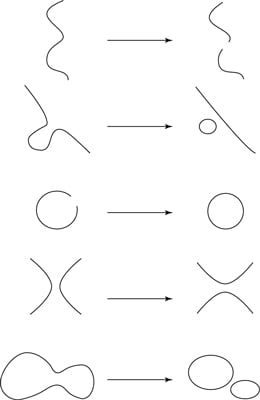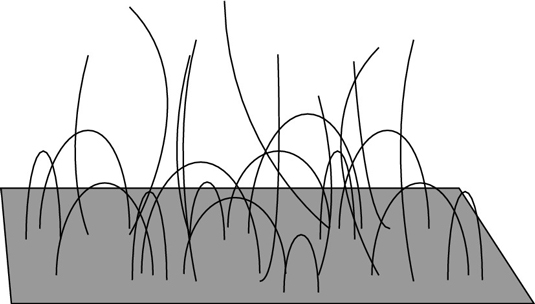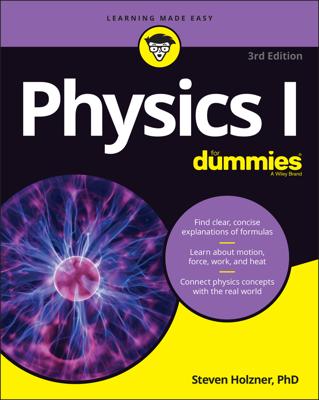Five key ideas are at the heart of string theory. Become familiar with these key elements of string theory right off the bat. Read on for the very basics of these five ideas of string theory in the sections below.
Strings and membranes
When the theory was originally developed in the 1970s, the filaments of energy in string theory were considered to be 1-dimensional objects: strings. (One-dimensional indicates that a string has only one dimension, length, as opposed to say a square, which has both length and height dimensions.)
These strings came in two forms — closed strings and open strings. An open string has ends that don’t touch each other, while a closed string is a loop with no open end. It was eventually found that these early strings, called Type I strings, could go through five basic types of interactions, as shown this figure.

The interactions are based on a string’s ability to have ends join and split apart. Because the ends of open strings can join together to form closed strings, you can’t construct a string theory without closed strings.
This proved to be important, because the closed strings have properties that make physicists believe they might describe gravity. Instead of just being a theory of matter particles, physicists began to realize that string theory may just be able to explain gravity and the behavior of particles.
Over the years, it was discovered that the theory required objects other than just strings. These objects can be seen as sheets, or branes. Strings can attach at one or both ends to these branes. A 2-dimensional brane (called a 2-brane) is shown in this figure.

Quantum gravity
Modern physics has two basic scientific laws: quantum physics and general relativity. These two scientific laws represent radically different fields of study. Quantum physics studies the very smallest objects in nature, while relativity tends to study nature on the scale of planets, galaxies, and the universe as a whole. (Obviously, gravity affects small particles too, and relativity accounts for this as well.) Theories that attempt to unify the two theories are theories of quantum gravity, and the most promising of all such theories today is string theory.
Unification of forces
Hand-in-hand with the question of quantum gravity, string theory attempts to unify the four forces in the universe — electromagnetic force, the strong nuclear force, the weak nuclear force, and gravity — together into one unified theory. In our universe, these fundamental forces appear as four different phenomena, but string theorists believe that in the early universe (when there were incredibly high energy levels) these forces are all described by strings interacting with each other.
Supersymmetry
All particles in the universe can be divided into two types: bosons and fermions. String theory predicts that a type of connection, called supersymmetry, exists between these two particle types. Under supersymmetry, a fermion must exist for every boson and vice versa. Unfortunately, experiments have not yet detected these extra particles.
Supersymmetry is a specific mathematical relationship between certain elements of physics equations. It was discovered outside of string theory, although its incorporation into string theory transformed the theory into supersymmetric string theory (or superstring theory) in the mid-1970s.
Supersymmetry vastly simplifies string theory’s equations by allowing certain terms to cancel out. Without supersymmetry, the equations result in physical inconsistencies, such as infinite values and imaginary energy levels.
Because scientists haven’t observed the particles predicted by supersymmetry, this is still a theoretical assumption. Many physicists believe that the reason no one has observed the particles is because it takes a lot of energy to generate them. (Energy is related to mass by Einstein’s famous E = mc2 equation, so it takes energy to create a particle.) They may have existed in the early universe, but as the universe cooled off and energy spread out after the big bang, these particles would have collapsed into the lower-energy states that we observe today. (We may not think of our current universe as particularly low energy, but compared to the intense heat of the first few moments after the big bang, it certainly is.)
Scientists hope that astronomical observations or experiments with particle accelerators will uncover some of these higher-energy supersymmetric particles, providing support for this prediction of string theory.
Extra dimensions
Another mathematical result of string theory is that the theory only makes sense in a world with more than three space dimensions! (Our universe has three dimensions of space — left/right, up/down, and front/back.) Two possible explanations currently exist for the location of the extra dimensions:
The extra space dimensions (generally six of them) are curled up (compactified, in string theory terminology) to incredibly small sizes, so we never perceive them.
We are stuck on a 3-dimensional brane, and the extra dimensions extend off of it and are inaccessible to us.
A major area of research among string theorists is on mathematical models of how these extra dimensions could be related to our own. Some of these recent results have predicted that scientists may soon be able to detect these extra dimensions (if they exist) in upcoming experiments, because they may be larger than previously expected.

